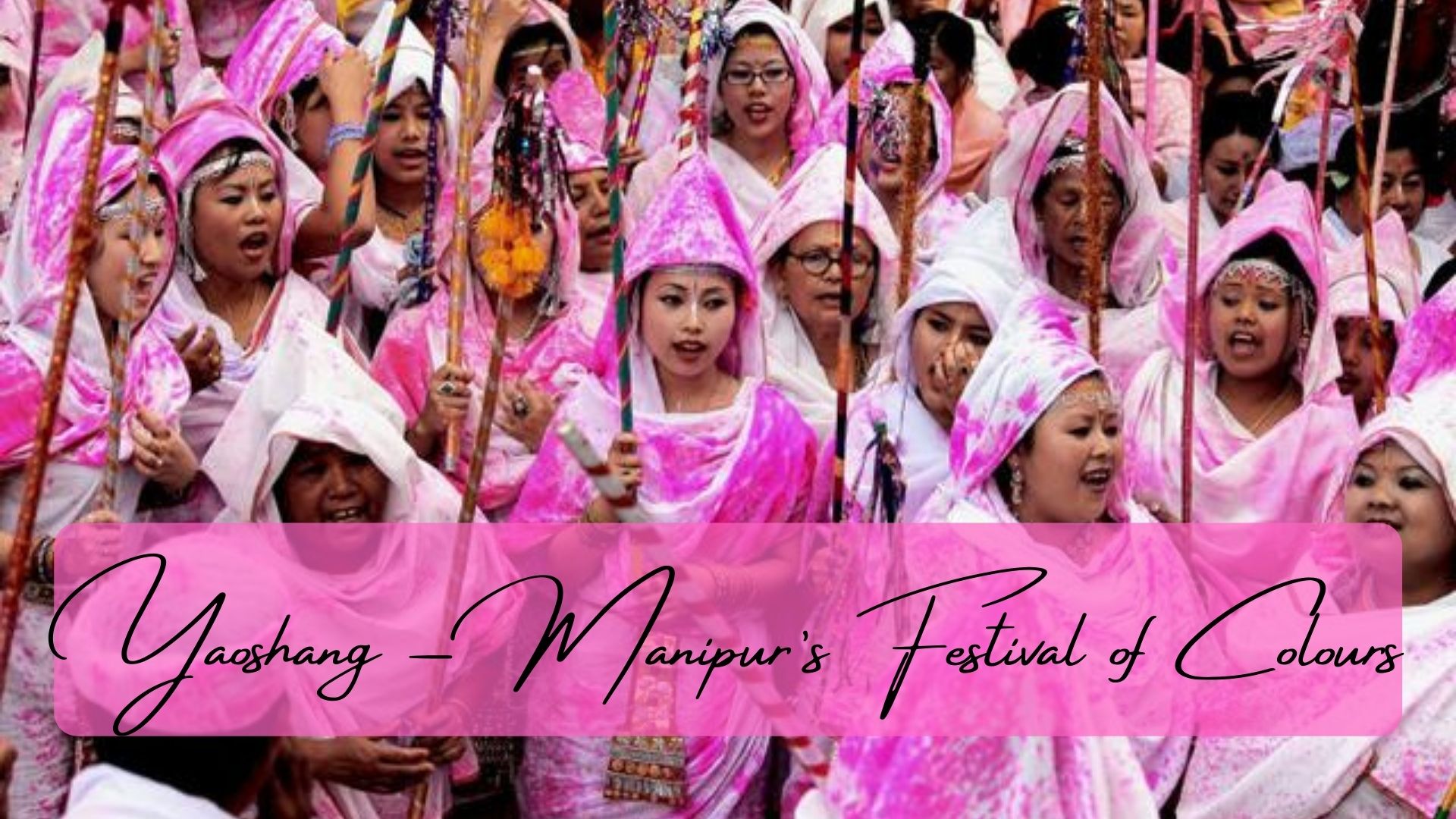
Yaoshang is Manipur’s own version of Holi – the festival of colours. It is a five-day long event that is observed on the full moon day of Lamda, the last month of the Meitei lunar calendar, which happens to be either end of February or early March as per the English calendar, around the same time as Holi. One of the most important festivals of the Meitei Hindus of Manipur, Yaoshang represents a beautiful blend of Sanatan Hindu traditions infused with local elements.
There are several such Hindu festivals in Manipur like Kang Rath Yatra, Heikru Hitongba (a traditional Manipuri boat race), and even Ningol Chakouba for that matter, which is celebrated around the same time as Deepawali and Bhaiyya Dooj in other parts of the country. This is the underlying cultural unity of our beautiful land called Bharat, which binds each and every region from the North to the South and the West to the North-East into one single territorial entity. Yaoshang represents the essence of the rich culture and traditions of the Meitei Hindus.
Originally, Yaoshang was celebrated in Kangleipak/Sanaleibak (present-day Manipur) commemorating the birth of Ebudhou Pakhangba, the presiding deity of the Sanamahi faith system of the Meiteis. It was on this day that Pakhangba was born at Kangla to Leimaren and Salailen Sidaba. In the earlier days, a separate house known as Naoshang (Nao meaning baby/child, and Shang meaning house) was built from locally available raw materials for the delivery of a baby. Pakhangba was born at a Naoshang, and the celebration of Yaoshang in Manipur formally began from the day of burning of the Naoshang of Pakhangba.
With the arrival of Gaudiya Vaishnavism in Manipur and Raja Meidingu Pamheiba making it the state religion in 1717 A.D., there was a healthy intermixture of Vaishnava traditions with the local Meitei Hindu customs of celebrating this festival. But, what does Yaoshang signify? Chaitanya Mahaprabhu who is worshipped as the founder of Gaudiya Vaishnavism in Manipur, is at the centre of this festival. In the morning of the very first day of Yaoshang, the murti of Chaitanya Mahaprabhu is placed in a small thatched hut made of bamboo and straws, which is especially constructed for the occasion.
This is then followed by the singing of bhajans and kirtans, offerings of prasadam, and collection of donations from the people of every locality (leikai), by young boys and girls dressed in traditional Manipuri attire. Similar to the ritual of the burning of the mehdah during the Doul Utsav celebrations in Barpeta district of Assam, in Manipur too, in the evening after sunset on the first day of Yaoshang, the murti of Chaitanya Mahaprabhu is removed from the hut. The hut is then set on fire amid chants of He Hari, He Ram, and Hari Bol. This ritual is known as Yaoshang Meithaba in the Manipuri language.
The ceremonial hut is being burnt in every Hindu locality of Manipur as an annual reminder of the greatness of Visnu in his avatar as Narasimha who had killed the demon Hiryánkashipu. The ash that is produced from the burnt hut is considered to be extremely auspicious. It is collected and smeared by the devotees on their foreheads. They also decorate the entrances to their homes with this ash. Yaoshang Meithaba not just marks the beginning of the Holi celebrations in Manipur but also the advent of the spring season. This is followed by Yaoshang Koiba, or visit to the homes of relatives and near-and-dear ones.
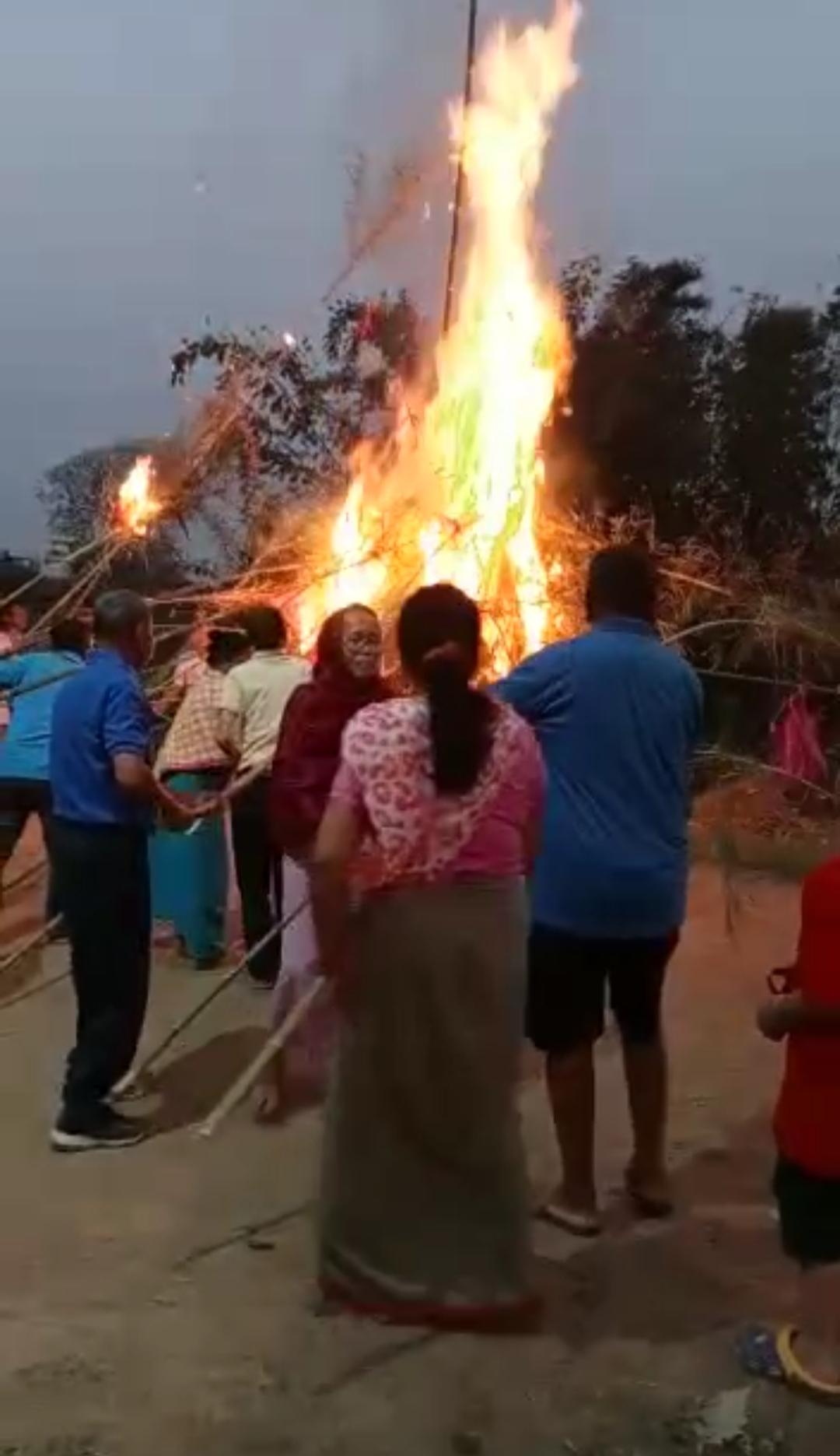
Locals taking part in the Yaoshang Meithaba ritual, in Imphal
Among the main celebrations of Yaoshang, there is a special ceremony called Nakatheng in which small children visit nearby homes showering blessings of success, prosperity and a long and healthy life upon the elders. In return, they receive gifts of money and clothes from the elders as a gesture of gratitude. As a part of Nakatheng, there is a beautiful tradition in which children block roads and the roadside traffic with ropes in their hands, to demand money from the passers-by which is obtained after exchanging some lighter moments of bargaining.
The prices can vary from Re. 1/- to Rs. 20/- and even Rs. 500/- but rarely more than that. The little kids are expected to buy sweets and toffees with the money they get and share it among themselves, as a celebration of the happy event. Nakatheng has thus come to be understood as a fund-raising effort undertaken mostly by girls, for merry-making during the Yaoshang festivities. Another important cultural highlight of Yaoshang is Thabal Chongba – a traditional Manipuri dance in which boys and girls hold each other’s hands and sing and dance in a circle to the tunes of the traditional Manipuri drum called pung.
Literally, Thabal Chongba means ‘moonlight dance’ for it is performed only at night. It is a typical Manipuri celebration of get-together on the night of Purnima. Thabal Chongba is a very special dance form that usually takes place on the second day of Yaoshang, but there is no strict rule as such and it can be performed on the other days of the festival as well, including the last night. In the traditional Manipuri Meitei society of the earlier times, since parents would not let their girls co-mingle with boys, they would make use of this night to mix up with boys from the neighbouring villages since the boys of their native village kept constant vigil.
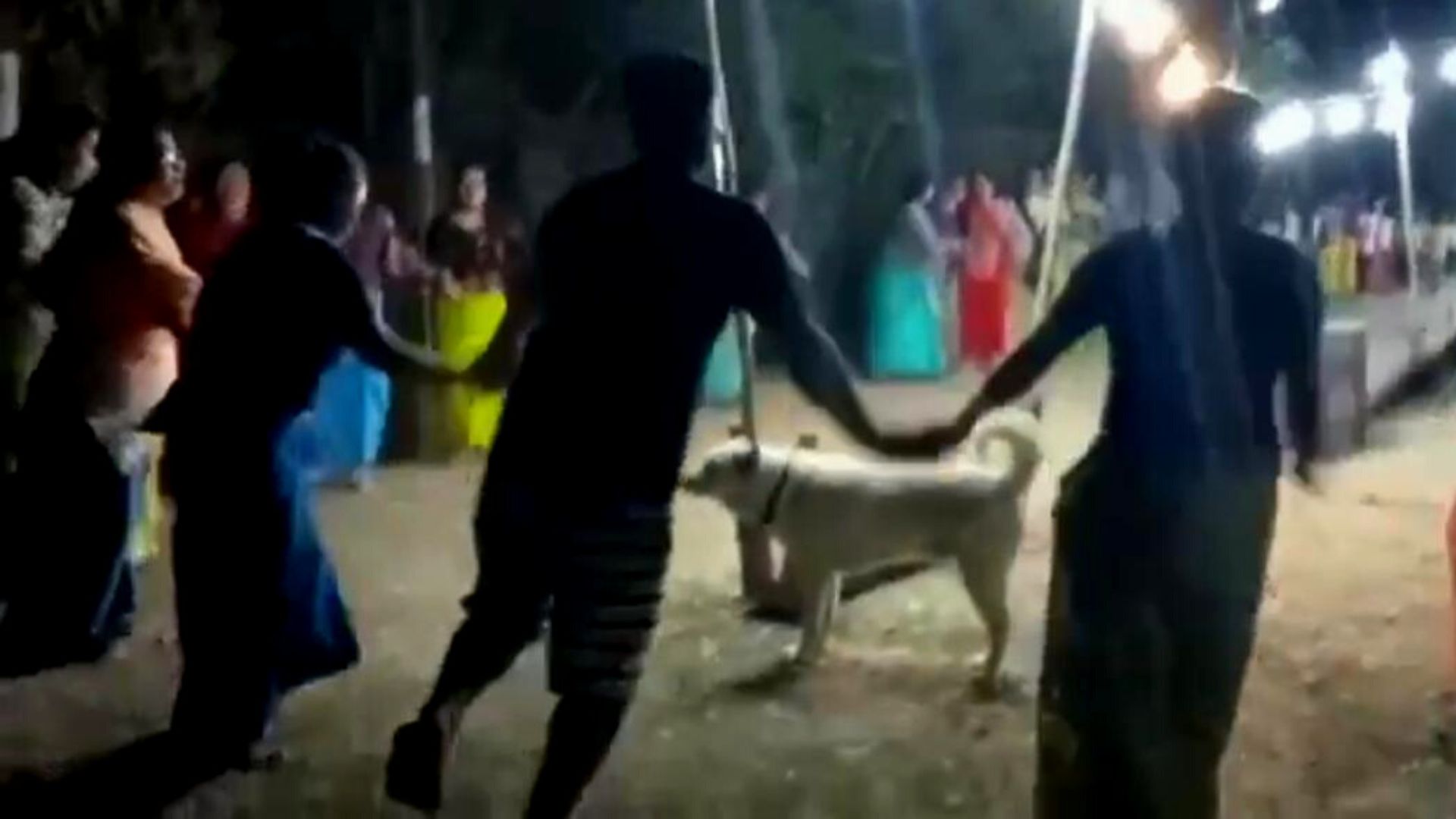
Thabal Chongba being performed during Yaoshang at a locality in Imphal
Thabal Chongba provides a chance for young boys and girls to know each other in front of their family members and local elders of their community. It is also performed as a mark of the celebration of any happy event such as marriage ceremonies, childbirth, etc. Sometimes, married women and young girls of the community organize their own Thabal Chongba events called Mou Thabal or Leishabi Chakchanaba, on the third day of Yaoshang. These have become an inseparable part of the Yaoshang festivities. A traditional theatre play called Shumang Leela which is based on the life of Sri Krisna is another major attraction of this festival.
Devotional songs called Pala Eshei dedicated to Govinda, are performed by Manipuri Nat Sankirtana bands which are especially trained for the festival of Yaoshang by the elders of the community. This tradition is also known as Holi Pala Esheishakpa. It is performed on the occasion of Yaoshang in Manipur at various Hindu religious places of worship such as the Shree Shree Govindajee Temple located at Wangkhei in Imphal East district. Originally built in 1846 A.D. during the reign of Maharaja Nara Singh and later rebuilt by Maharaja Chandrakriti in 1876, the Govindajee temple happens to be the largest Hindu temple of Manipur. It houses the murtis of different Devis and Devátás.
However, can any discussion of Holi leave behind the important role that colours play in our lives? Colours constitute a significant aspect of the Yaoshang celebrations too. People apply colours on the faces of each other in a ceremony known as aberteinaba, and children splash water among themselves with water guns known as pichkari. In fact, the second day of Yaoshang is also better known as the Pichkarinumit (Pichkari day). This joy and excitement of playing with colours continues till the fifth or the last day of the festival. A procession is being taken out to a local temple where people pray to their different Kula-Devis and Devátás by offering gulaal.
Traditional Manipuri games and sports such as Mukna, Yubi Lakpi, and Laphu Kabee, are some of the other interesting and popular highlights of this festival. One after the other sports event is held during all the four to five days of Yaoshang. Hence, Yaoshang is also essentially hailed as the “Olympics” of the Meiteis of Manipur in which various sports competitions are organised alongside the traditional festivities. These events are mostly organised by local communities and clubs in their own local grounds and sometimes even on the roadsides, during the five days of Yaoshang.
On the very first day itself, a sacred fire is lit to commence the beginning of the festival after which a huge procession is taken out from the Kangla Fort in Manipur to inaugurate the local sports meet. Small children, local clubs, and various other important personalities of the state converge at this fort to light their torches after which, they carry this sacred flame to the sports complex where the events are being organised. The idea behind organising games and sports competitions during Yaoshang is to infuse among the youth of Manipur the importance of living a healthy and active life free from diseases.
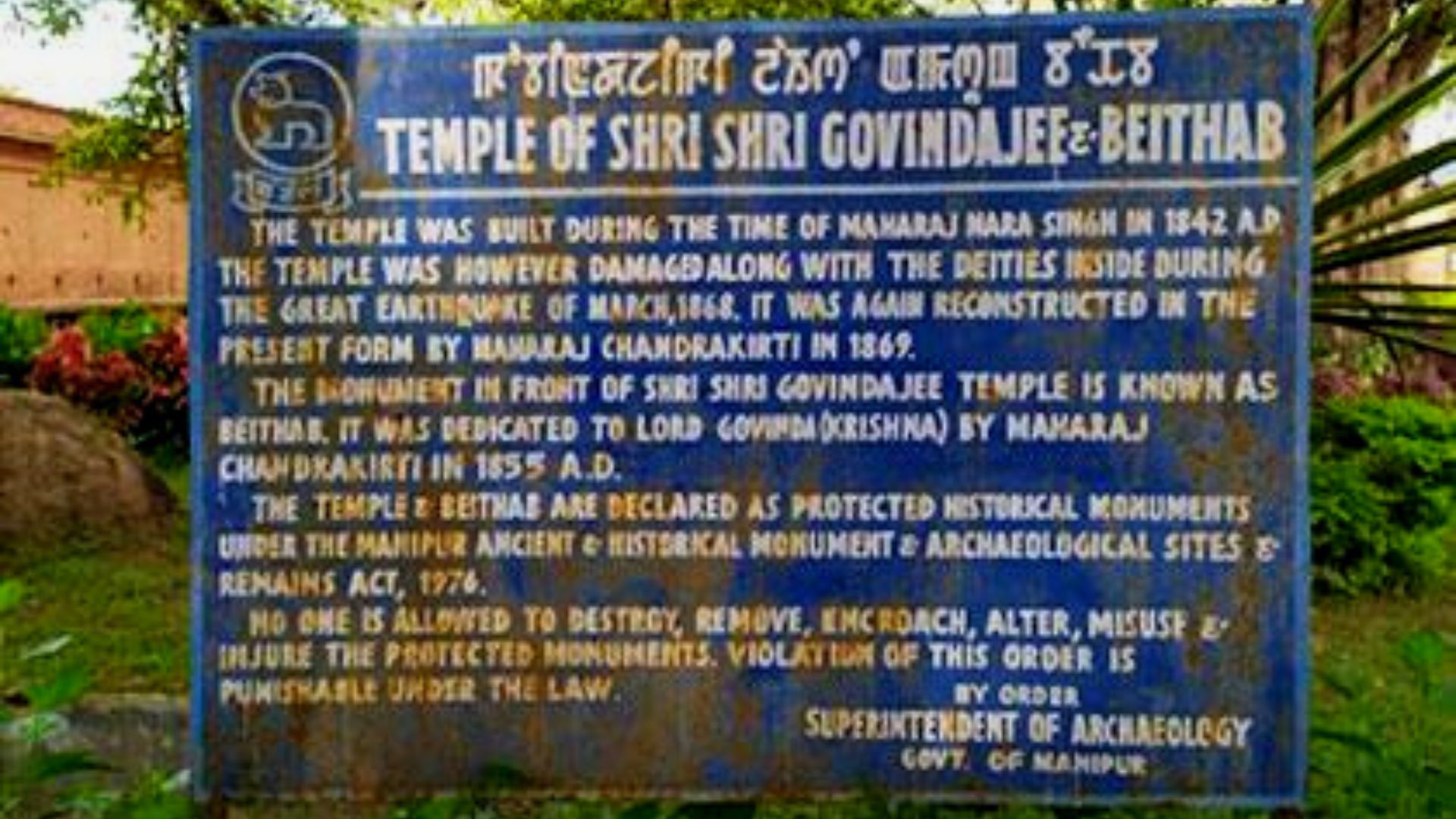
Outside the Shree Shree Govindajee temple in Imphal, Manipur
It is an integral part of the Holi celebrations in Manipur that aims to foster the spirit of kinship and sportsmanship, besides encouraging talents. From recreational games to competitive sports, the games and sports events during Yaoshang witnesses participation of people from almost every age group. In many places of Manipur’s capital Imphal, Yaoshang has almost become synonymous with games and sports. Yaoshang finally comes to an end with a special religious ceremony called Brajamai that takes place on the fifth and the last day of this festival. A massive pala begins from the Shree Shree Govindajee temple to the Sri Bijaya Govinda temple at Sagolband Mantri Leikai.
This procession is known as Sri Govindajee Halankar (also referred to as Holi nowadays). It is a re-enactment of various scenes from Krisna Leela in the form of musical and dance performances. A ceremonial procession of Lakhi Keithel Kaba (Ma Laksmi) is also being taken out from Kangla towards Khwairamband Keithel, one of the largest and famous market complexes at Kangla, Imphal. Offerings of fruits and sweets along with prayers are being made to the deities. After Halankar comes to an end, the women splash colours and vermillion (sindoor/kumkuma) on one another, which formally marks the closure of this festival.
(The writer is currently associated as an Assistant Professor with the Center for Indic Studies, Indus University, Ahmedabad).
(A special note of thanks to Jayalaxmi and her family for enlightening me on various minute details of Yaoshang and also facilitating my visit to Imphal from March 26-30, 2021).
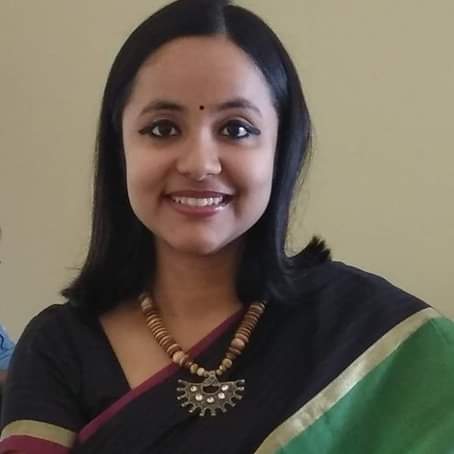
The writer is associated with the Center for Indic Studies, Indus University, Ahmedabad as an Assistant Professor. Her area of interest is North East India, it's history, culture and civilization before the advent of Christianity in the region. She is also a public speaker, writer and Columnist.
NEXT ARTICLE

At the southernmost tip of this mesmerising ensemble lies the majestic Great Nicobar Island, boasting an impressive landmass of about 910 square kilom...

Bharath has always been a land traversed by spiritual masters/ Guru since time immemorial. These spiritual masters have always upheld the core princip...

South India contains its fair share of unique pilgrimage centres. These divine places of worship have a prominent Sthala Purana, devoted followers, di...